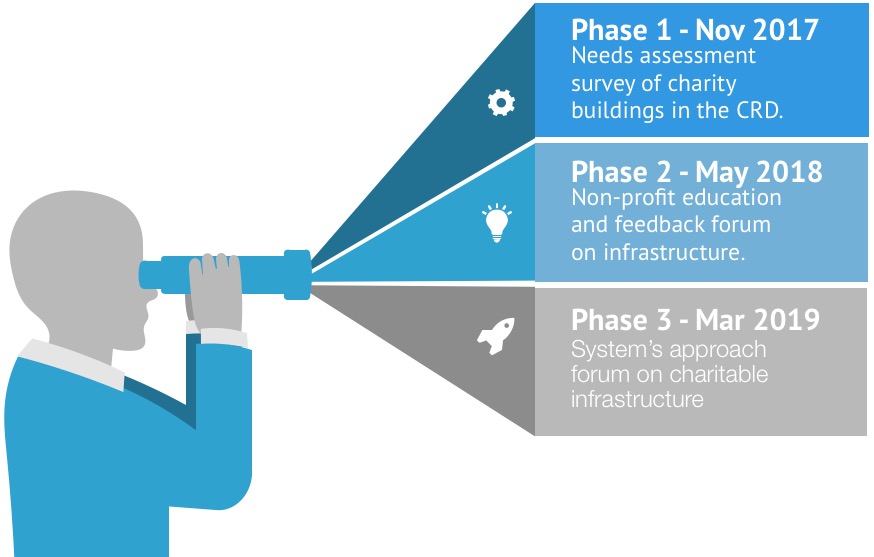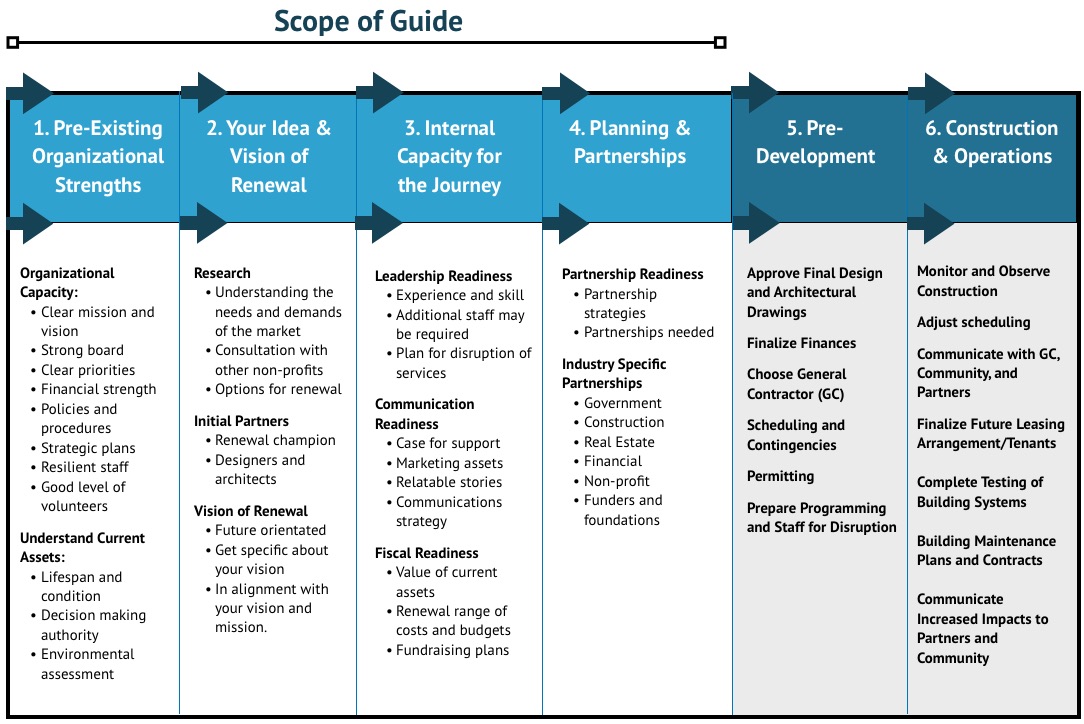Infrastructure Study and Handbook
Study and Assessment Report on Charity Buildings
HeroWork’s experience has shown us that many charity buildings are in need of repairs or upgrades. We’ve seen the evidence across the non-profit sector in the Victoria region. It is our mission to make this better—to improve community infrastructure so that charities can have a bigger impact.
However, before this study was done our evidence was anecdotal. No data existed on the state of non-profit buildings—not in the Greater Victoria area nor anywhere else in Canada. In order to serve other charities better, we wanted to deeply understand the infrastructure needs.
This was why we embarked on a study of physical charitable infrastructure in the Greater Victoria area.

Charity Infrastructure Renewal Guide
Infrastructure renewal starts with a need and a vision. With hard work, strategy and perseverance that vision turns into bricks and mortar.
The diagram on the next page visualizes the steps to take to have a successful journey and outcome. Although each step is separated, in reality several steps can be happening at once.

The first step is to ensure your organization is ready to embark on the journey. It improves your organizational capacity and understanding to ensure your charity has the resilience and ability to manage each of the subsequent steps.
The second step helps you to explore your idea and vision of infrastructure renewal, asking questions regarding your research, initial partners, financial constraints, and the feasibility of your vision.
The guide goes on to explore your charity’s internal capacity, looking at leadership, communications, and fiscal readiness.
Then it switches towards your capacity to manage external partners, providing suggestions gleaned from many leaders in each of the 6 industries that make up the “system” through which charity infrastructure exists, operates, and is renewed.
This guide does not go into the details of the last two phases—pre-development and construction/operations—as these phases are often technical and too widely varied to be contain within this short guide. However, if a charity does a good job at the first four stages they are well prepared for the final legs of the journey.
At each stage, it’s crucial for your organization to use your mission and vision as a lens to decide how to proceed.
Infrastructure Innovation Case Studies
Food Bank Model
The Mustard Seed is a well-loved and long-term charity of Victoria, which runs the largest food bank on Vancouver Island. But they had been operating a typical food hamper program for years, where clients would come in, be interviewed, and a volunteer would pick, pack, and provide a box of food for a family. To reduce waste and provide a more dignified experience, the Mustard Seed developed a vision of a “grocery store-style market” in which clients could choose their own food for their families. The problem was that their warehouse was ugly, ill-equipped, and not at all designed to become a type of social grocery store. Plus, they didn’t have the fiscal resources required for an upgrade.
HeroWork partnered with them and developed concepts, plans, and drawings that brought their vision to life. Then HeroWork mobilized over 100 companies and 500 volunteers, contributing hundreds of thousands of dollars’ worth of in-kind labour and goods.
Today the Mustard Seed operates one of the most innovative programs in the province, serving the food insecure of Victoria in a more efficient and humane way.
Recovery Program
The Our Place Society has been helping the impoverished, mentally and physically challenged, addicted and homeless for decades. Through their years of experience, they discerned that homelessness, addiction, and incarceration represent a repeating, complex, and interconnected pattern that kept people entrenched on the streets.
Our Place researched an innovative solution, modelled from an Italian community called San Patrignano that reports a 72% full-recovery rate for thousands of residents who complete their program. Through several deep partnerships they were able to get a long-term lease of an old youth detention facility to operate a Therapeutic Recovery Community. The problem was that the facility needed extensive and expensive renovations to make it look, feel, and operate like a home, not a jail.
They partnered with HeroWork to save hundreds of thousands of dollars on a complex and wide-ranging renovation that now enables them to operate an innovative Therapeutic Recovery Community that, we believe, will become a new model of treatment in Canada.
Thanks to Our Sponsors for this Study and Handbook

